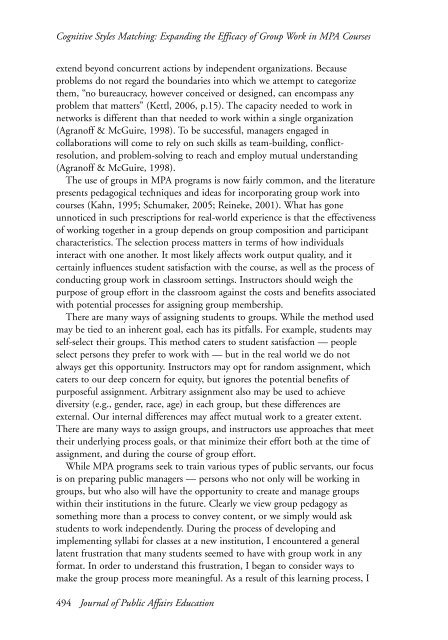JOURNAL OF PUBLIC AFFAIRS EDUCATION - National ...
JOURNAL OF PUBLIC AFFAIRS EDUCATION - National ...
JOURNAL OF PUBLIC AFFAIRS EDUCATION - National ...
Create successful ePaper yourself
Turn your PDF publications into a flip-book with our unique Google optimized e-Paper software.
Cognitive Styles Matching: Expanding the Efficacy of Group Work in MPA Courses<br />
extend beyond concurrent actions by independent organizations. Because<br />
problems do not regard the boundaries into which we attempt to categorize<br />
them, “no bureaucracy, however conceived or designed, can encompass any<br />
problem that matters” (Kettl, 2006, p.15). The capacity needed to work in<br />
networks is different than that needed to work within a single organization<br />
(Agranoff & McGuire, 1998). To be successful, managers engaged in<br />
collaborations will come to rely on such skills as team-building, conflictresolution,<br />
and problem-solving to reach and employ mutual understanding<br />
(Agranoff & McGuire, 1998).<br />
The use of groups in MPA programs is now fairly common, and the literature<br />
presents pedagogical techniques and ideas for incorporating group work into<br />
courses (Kahn, 1995; Schumaker, 2005; Reineke, 2001). What has gone<br />
unnoticed in such prescriptions for real-world experience is that the effectiveness<br />
of working together in a group depends on group composition and participant<br />
characteristics. The selection process matters in terms of how individuals<br />
interact with one another. It most likely affects work output quality, and it<br />
certainly influences student satisfaction with the course, as well as the process of<br />
conducting group work in classroom settings. Instructors should weigh the<br />
purpose of group effort in the classroom against the costs and benefits associated<br />
with potential processes for assigning group membership.<br />
There are many ways of assigning students to groups. While the method used<br />
may be tied to an inherent goal, each has its pitfalls. For example, students may<br />
self-select their groups. This method caters to student satisfaction — people<br />
select persons they prefer to work with — but in the real world we do not<br />
always get this opportunity. Instructors may opt for random assignment, which<br />
caters to our deep concern for equity, but ignores the potential benefits of<br />
purposeful assignment. Arbitrary assignment also may be used to achieve<br />
diversity (e.g., gender, race, age) in each group, but these differences are<br />
external. Our internal differences may affect mutual work to a greater extent.<br />
There are many ways to assign groups, and instructors use approaches that meet<br />
their underlying process goals, or that minimize their effort both at the time of<br />
assignment, and during the course of group effort.<br />
While MPA programs seek to train various types of public servants, our focus<br />
is on preparing public managers — persons who not only will be working in<br />
groups, but who also will have the opportunity to create and manage groups<br />
within their institutions in the future. Clearly we view group pedagogy as<br />
something more than a process to convey content, or we simply would ask<br />
students to work independently. During the process of developing and<br />
implementing syllabi for classes at a new institution, I encountered a general<br />
latent frustration that many students seemed to have with group work in any<br />
format. In order to understand this frustration, I began to consider ways to<br />
make the group process more meaningful. As a result of this learning process, I<br />
494 Journal of Public Affairs Education

















